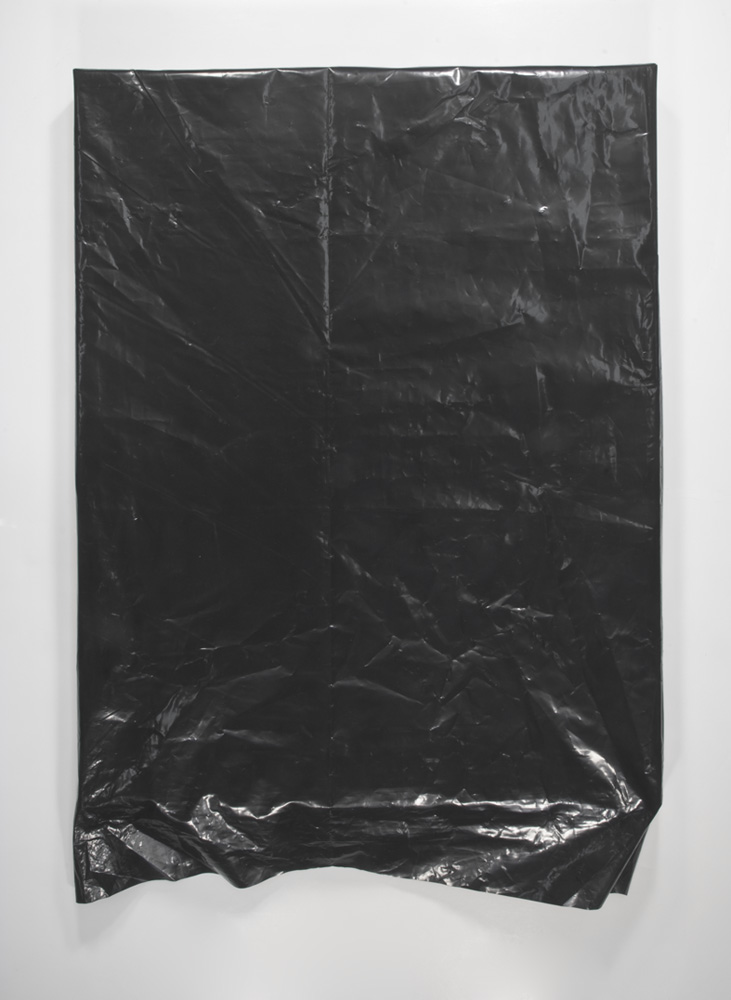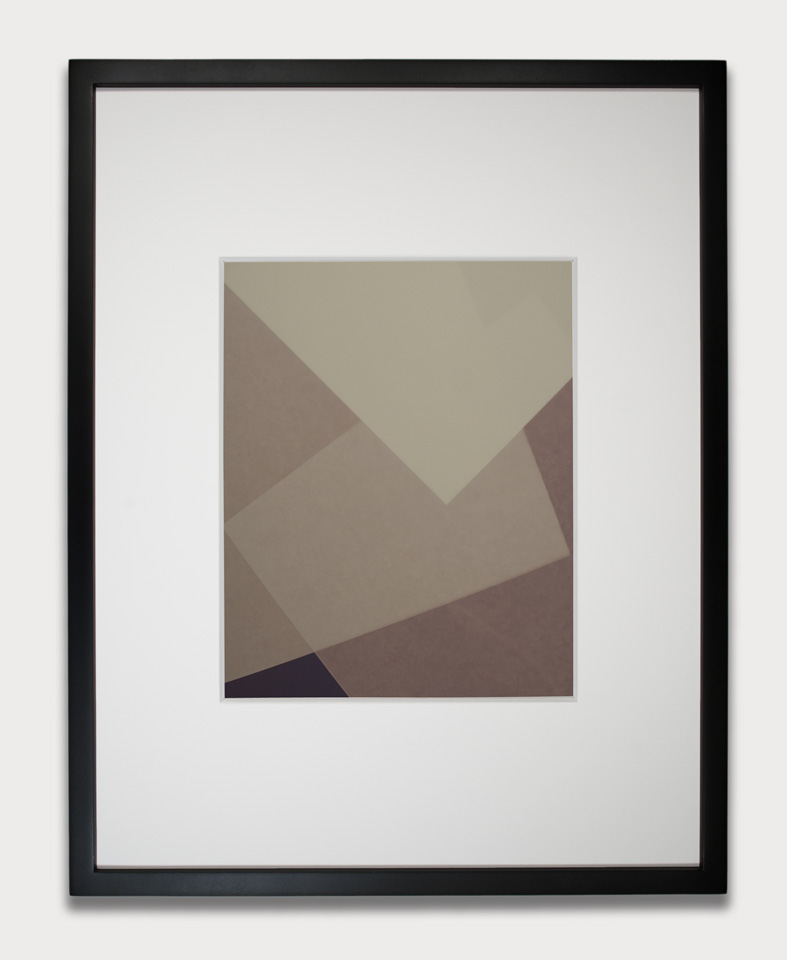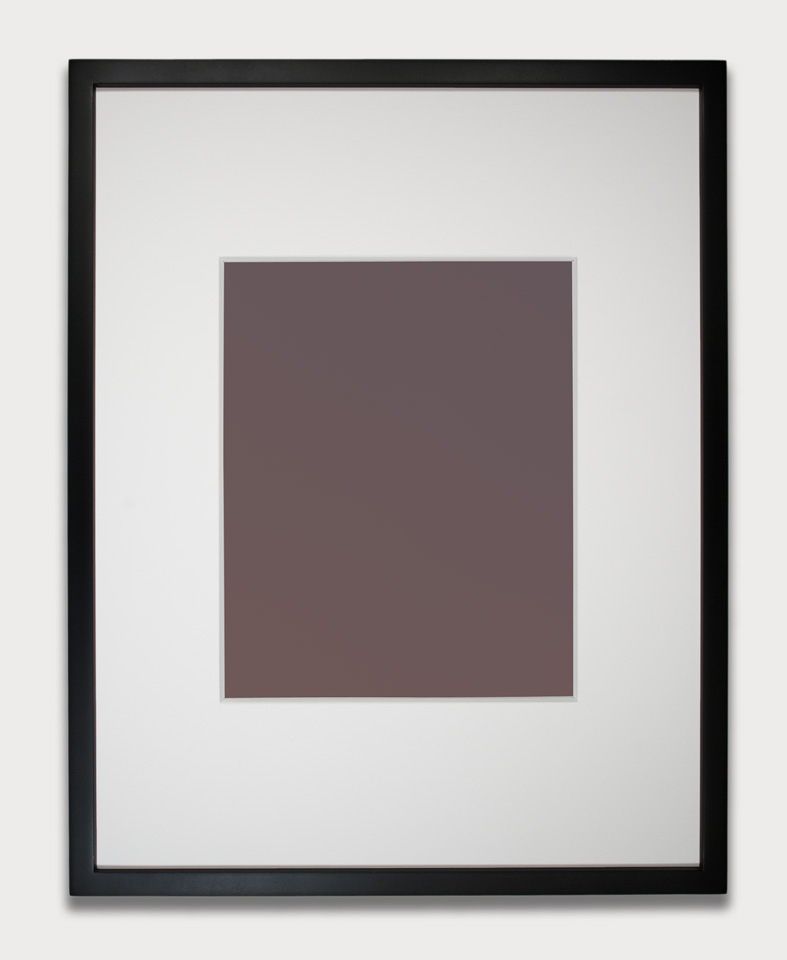This essay was written for and in conjunction with Phil Chang’s show Cache, Active, currently up at LAXART.
The photographs and photograms in Phil Chang’s Cache, Active series are on expired photographic paper that has been left unfixed. This means that when they are exposed to light, the image very quickly begins to fade and, after several hours, pretty much disappears, leaving instead a reddish brown monochrome. There is an important sense in which you don’t simply look at these photographs, you watch what they’re doing; it’s a kind of performance. And it’s more like a live performance than a movie or video since it’s not repeatable—you can’t just play it again when it’s over. But also—and here the performance model gets complicated—it’s not just over when it’s over. Something (the monochrome) remains. So what we’re being asked to pay attention to is not just the performance and not just the final object but the relation between them.
When I first saw one of these works, it was wrapped in black plastic to keep out the light.

When the plastic was taken off, it looked for a while like this, depicting several sheets of layered paper on what is, of course, another sheet of paper, the (untreated) photographic paper. Because of the layering, the surfaces depicted in the photogram have real volume. Its title, Two Sheets of Thick Paper on Top of Two Sheets of Thin Paper, suggests Chang’s own interest in that fact. By contrast, the thickness or thinness of the paper that constitutes the object—the photogram itself, a section of which is visible as black on the bottom—seems immaterial. There are, in other words, five pieces of paper visible in the photo but only four depicted. And at the same time, what we’re actually looking at is only one piece of paper, but the question of its thickness or thinness is never raised. So what I mean by calling the volume of the photographic paper immaterial is, first, that the photogram renders the thickness of the paper it’s on irrelevant and, second, that this irrelevance – the difference between the paper it’s a picture of and the paper it’s on—is significant. This is what the photogram is about. And significance is not a physical property of the picture; aboutness is not material.

At the same time, however, the materiality of the photographic paper—not its volume but the fact that it’s expired and untreated—does turn out to matter. As the light begins to take effect, the depicted paper (the two thick sheets on top of the two thin ones) becomes harder and harder to see. Which means not only that the contrasting colors and volumes of the paper are lost but that the contrast between the (paradoxical) immateriality of the photogram as an object and the (inversely paradoxical) materiality of its subject also begins to disappear. Insofar as we have thought of the photograph not just as embodying this contrast but as being about it, it’s not only the contrast but also the aboutness that fades. The original photogram depicted sheets of paper; fading to reddish brown, it stops depicting anything. The original photogram was about the immateriality of the difference between a piece of paper and the representation of a piece of paper. The eventual monochrome may be understood as having lost or abandoned or repudiated (it’s hard to find a non-affective verb) its capacity to represent, and as having thus given up the claim to represent anything. Or it might be understood as asserting a claim to its materiality.
And, if we read Cache, Active this way, we can begin to locate it in relation to some other significant efforts of 21st-century artistic production, all of which we might place under the general heading of what Tom McCarthy, citing the philosopher Simon Critchley, calls letting “matter matter.”1 McCarthy’s own Remainder, with its commitment to what he calls “sheer materiality,”2 would be an instance, as would, in photography, what James Elkins describes as Marco Breuer’s efforts to make photographs that “undermine representation”3 and, in sculpture, what Julian Rose calls the “completely nonmetaphoric structures” of Oscar Tuazon.4 For Tuazon, “the problematic is never one of representation” His “fundamental achievement,” according to Rose, is “to build a structure that does not look like but is.”5 We can see the relevance of this formulation to Chang just by noting the way in which the pictures in Cache, Active may be understood precisely to begin by looking like but end by simply being. Moreover, if we extend our range to the invocation in Stephen Best’s and Sharon Marcus’s influential essay, “Surface Reading” of Susan Sontag’s antecedent formulation—the critic should concern herself with “what [a work] is” rather than “what it means”—we can begin to see the pictures in Cache, Active not just as exemplifying, but as enforcing this shift of attention.6 They don’t just let matter matter, they make metaphor, meaning and representation itself into matter.
So far, then, we have a photo that begins by being about the difference between what it is and what it represents but, as the representation disappears, undoes that difference, leaving behind a remnant of the picture. But when we put it this way, it’s not hard to see that any account along these lines can’t quite be right since, if it’s possible to see the final monochrome as the culmination of the process through which a picture disappears, it’s possible also to see it as the culmination of the process through which a picture is created. How did Chang make the particular monochrome I saw? By making a photogram on expired photographic paper, leaving the image unfixed and exposing it to light. What I’ve been calling the work’s performance is nothing other than the causal account of its production, the kind of account you can give for any work of art. The difference is just that Chang has folded the process through which the work was produced into the experience of seeing it. But this is a difference that matters. For one thing, in a kind of paroxysm of medium specificity, it absolutely insists that the monochromes be seen as photographs. And, for another, in insisting that the way the monochromes have been made is crucial to our experience of them, it makes them into objects that have to be understood, objects that don’t resist interpretation, but require it.

We see the final monochromes not only as being what they are but, as having a relation to what they aren’t—or, at least, aren’t any more. They are, in a certain sense, abstractions, in a kind of variation on the old Lacanian formula—“the symbol manifests itself first of all as the murder of the thing.” They continue to bear a relation to the depicted things they have replaced. And although this relation is most obvious in some of the photographs where you can actually see a trace of the original image, it’s just as important when you can’t, where, as in the photograms, the indexical trace of the image has been effaced and what the monochrome marks is precisely that effacement. In both cases, the monochromes thus signify the absence of the original image, functioning either as a kind of screen behind which what once was visible can be imagined to have retreated or as a kind of epitaph for something that is gone. And this signifying function marks an inversion of the demand for the thing that, instead of meaning, “simply is.” What we get here is a thing that (in order to mean) cannot simply be, i.e., a thing determined in its being as much by what it isn’t as by what it is.
Cache, Active thus embodies an encounter not just with meaning but, to recall Michael Fried’s famous remark about the sculpture of Anthony Caro, with “meaningfulness as such.” But if, in one way, this parallel is almost exact—the position Fried was writing against in “Art and Objecthood” has more than a family resemblance to the one articulated by Rose, Tuazon, Critchley, et al—in another way, it’s a little misleading. The modernists Fried was defending had developed their own position prior to and independent of Minimalism, whereas Chang (born in 1974) has never lived in an art world in which the appeal of the literal—call it postmodernism—was not being articulated in one form or another. His position is indelibly marked by a certain intimacy with rather than a straightforward refusal of the literal.
This difference between “meaningfulness” at the beginning of postmodernism and meaningfulness today is not just an art historical one. It’s also an economic one. Whether you measure by the increase in inequality at home or the spread of capitalism abroad, the penetration of the market into every corner of the globe and every form of production—including, obviously, the production of art—is complete today in a way that seemed almost unimaginable in the late 60s and early 70s. So if it’s true that an artist like Chang has never lived in an art world without the postmodern, it’s also true that he has never lived in an America in which inequality wasn’t increasing. Since the year of his birth, all the growth in American income has gone to the top 10% while the income of the bottom 90% has actually declined. It was once possible for a writer like Douglas Crimp to imagine a truly “materialist critique of art” (his exemplary instance was Serra) that would resist the “idealism of modern sculpture” (Caro) and seek “to defeat consumption altogether”—that would replace the experience of art as a “luxury commodity” with “the experience of art in its material reality.”7 Today that ship has sailed to, and then back from, Shenzhen. In fact, today, if we’re looking for something to emblemize what it might mean to resist the commodity, almost the only place we can find it is in the idealism that Crimp deplored, in the resistance to the material that we see in Cache, Active.
As Nick Brown has emphasized in “The Work of Art in the Age of its Real Subsumption Under Capital,” the distinguishing feature of the commodity, is the fact that, produced only to be sold, what matters about it is never what it was intended to do but only that it gets bought. As the producer of the commodity, I may make something for you to use in a certain way but what counts is only that you buy what I made; what you actually do with it is your business. And if, in art, we’ve usually put the point in more positive terms (think of the critique of the artist’s intentionality and the celebration of indeterminacy, of the artist’s willingness to give up control of the work, etc.), nevertheless it’s been the same point. With art, then, as with any commodity, not only is the price of the work determined by its buyers, so also are the uses to which it’s put. And the experience they have of it is their experience. In fact, the only thing about the work of art that is not determined by its buyers, the only thing about it that’s not reducible to the commodity it otherwise is, is its meaning.
That’s why Cache, Active’s insistence on the experience of meaning is both its aesthetic and its politics. The response to these pictures that Phil Chang presumably wants is for us to like them and buy them. But what the pictures Chang has made require is something more like our understanding than our affection, and they not only require it, they also dramatize the specificity of the requirement. This is what’s at stake in the encounter they stage with their own materiality; the felt power of the reduction to being is what gives their insistence on meaning its force. And it’s also why the sense of loss as the original image fades is crucial but not dispositive: we can’t help feeling something but it doesn’t matter what we feel. And like the disarticulation of meaning from being, the disarticulation of meaning from feeling requires an encounter with its appeal. It’s only the intimacy with what it doesn’t do that makes it possible for Cache, Active to do what it does.
Notes